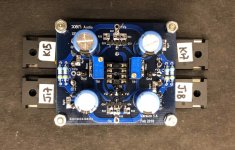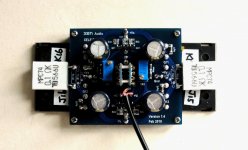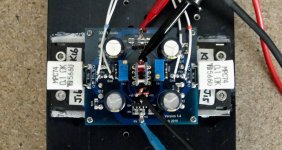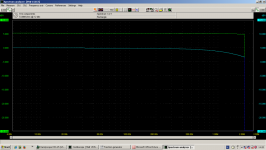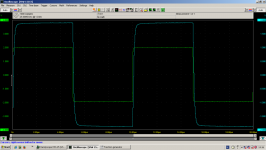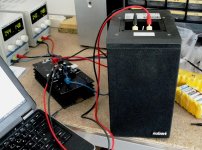The XEN XELF Headphone & Speaker Buffer
After finsihing our DIP-8 discrete opamps, we want to have a platform to test its sonic performance.
One Last Attempt at Discrete Opamp in DIP8 Footprint
Morde has built a few of our projects and we know he has a WHAMMY.
He was kind enough to test one of the opamps for us against the OPA627, using the WHAMMY as a platform :
https://www.diyaudio.com/forums/pas...s-diy-headphone-amp-guide-28.html#post5780536
(post #1375)
But we thought we should have our own platform to test as well.
So we asked ourselves the question -- how would our own "WHAMMY" look like ?
The result is the XELF, or XEN Lateral FET Buffer.
Patrick
.
After finsihing our DIP-8 discrete opamps, we want to have a platform to test its sonic performance.
One Last Attempt at Discrete Opamp in DIP8 Footprint
Morde has built a few of our projects and we know he has a WHAMMY.
He was kind enough to test one of the opamps for us against the OPA627, using the WHAMMY as a platform :
https://www.diyaudio.com/forums/pas...s-diy-headphone-amp-guide-28.html#post5780536
(post #1375)
But we thought we should have our own platform to test as well.
So we asked ourselves the question -- how would our own "WHAMMY" look like ?
The result is the XELF, or XEN Lateral FET Buffer.
Patrick
.
Attachments
Last edited:
Listening Impressions
The brave man also acted as our Alpha tester.
This was deliberately to test out whether it is also suitable for those not-so-experienced DIYer's.
And of course, since he has a WHAMMY, we have a benchmark to go against.
To quote his listening impressions (with his consent) :
"I had some time to spend comparing XELF with the PASS DIY Whammy.
I had installed OPA627 opamps to both.
I did the comparison without Xfeed since it was easier that way and I was able to run them right after the other.
I used my trusty LCD-2f phones for testing and the volume levels were matched with 1kHz sine wave and DMM.
The XELF was powered with regular AA sized batteries and the Whammy obviously via it’s own supply.
Bias was ~190mA with XELF and battery voltages ~+-14V.
The listening impressions -- I have to say that XELF has the same kind of easiness and open sound as the UTHAiM.
Very effortless. Some magic with the Exicon lateral FETs?
Bass was deeper and control better with XELF. Evident with samples like:
Children Of Bodom - Blooddrunk, The Mars Volta - Wax Simulacra
Vocals had more presence too with XELF and Norah Jones seemed to be singing in my living room.
Whammy was very close in this regard but I noticed the difference.
Then I plugged in the Xen discrete opamp and oh boy, something just clicked into right position.
It’s like a filter would have been removed between my ears and headphones.
Soundstage is wider and sound is crystal clear. Definitely a bigger change than changing opamps with Whammy.
I guess the XELF buffer has a lot of potential so the opamp makes a bigger effect."
Seems he is keeping the XELF and planning to build the discrete opamps as well.
🙂
Patrick
The brave man also acted as our Alpha tester.
This was deliberately to test out whether it is also suitable for those not-so-experienced DIYer's.
And of course, since he has a WHAMMY, we have a benchmark to go against.
To quote his listening impressions (with his consent) :
"I had some time to spend comparing XELF with the PASS DIY Whammy.
I had installed OPA627 opamps to both.
I did the comparison without Xfeed since it was easier that way and I was able to run them right after the other.
I used my trusty LCD-2f phones for testing and the volume levels were matched with 1kHz sine wave and DMM.
The XELF was powered with regular AA sized batteries and the Whammy obviously via it’s own supply.
Bias was ~190mA with XELF and battery voltages ~+-14V.
The listening impressions -- I have to say that XELF has the same kind of easiness and open sound as the UTHAiM.
Very effortless. Some magic with the Exicon lateral FETs?
Bass was deeper and control better with XELF. Evident with samples like:
Children Of Bodom - Blooddrunk, The Mars Volta - Wax Simulacra
Vocals had more presence too with XELF and Norah Jones seemed to be singing in my living room.
Whammy was very close in this regard but I noticed the difference.
Then I plugged in the Xen discrete opamp and oh boy, something just clicked into right position.
It’s like a filter would have been removed between my ears and headphones.
Soundstage is wider and sound is crystal clear. Definitely a bigger change than changing opamps with Whammy.
I guess the XELF buffer has a lot of potential so the opamp makes a bigger effect."
Seems he is keeping the XELF and planning to build the discrete opamps as well.
🙂
Patrick
Links for the References :
1. One Last Attempt at Discrete Opamp in DIP8 Footprint
2. http://xen-audio.com/documents/xen-zgf/ZGF Desktop Description V1.pdf
3. Auto-Biasing Circuits for Complementary Followers
4. US Patent 4752745 Opto-isolated bias circuit for operating push-pull amplifiers in Class A and Class AB modes
5. JFETs: The New Frontier, Part 2 | audioXpress
6. Taylor Source Follower
7. The Pioneer Super Linear Circuit
8. XCEN Balanced to Single-Ended Converter Revisited
9. http://www.diyforums.org/phpBB3/viewtopic.php?f=2&t=13&p=136
__https://www.amb.org/ti/audio/mosfet_buffer_sch.png
Patrick
1. One Last Attempt at Discrete Opamp in DIP8 Footprint
2. http://xen-audio.com/documents/xen-zgf/ZGF Desktop Description V1.pdf
3. Auto-Biasing Circuits for Complementary Followers
4. US Patent 4752745 Opto-isolated bias circuit for operating push-pull amplifiers in Class A and Class AB modes
5. JFETs: The New Frontier, Part 2 | audioXpress
6. Taylor Source Follower
7. The Pioneer Super Linear Circuit
8. XCEN Balanced to Single-Ended Converter Revisited
9. http://www.diyforums.org/phpBB3/viewtopic.php?f=2&t=13&p=136
__https://www.amb.org/ti/audio/mosfet_buffer_sch.png
Patrick
Yes indeed, you can easily wind up the bias with suitable heatsinking.
And with an opamp in a NFB loop also low enough output impedance.
Patrick
And with an opamp in a NFB loop also low enough output impedance.
Patrick
Driving Speakers
I received a set of Exicons from a generous donor and built my own prototype today.
Quite straight forward, without any events.
Even without trimming, imbalance between the top and bottom current sources were less than 4µA.
As I wanted to test it both for driving headphones and speakers, I reduced the CCS bias a bit to 1mA.
The biasing resistors for the lateral MOSFETs were then set to give 200mA.
If I now then add another 0.5mA in parallel to the CCS, I shall increase the output bias to 550mA.
You can eassily increase further to 1A bias by adding 1mA to the CCS instead.
As expected, with the opamp in place, changing bias does not affect DC offset at all.
And I used a MPC74 0.1R as source resistor, as to be 100% safe when driving speakers.
The XELF alone has a -3dB bandwidth of 2MHz with 33R load, and even higher without load (-1.5dB at 2MHz).
With the discrete opamp in place, bandwidth is limited by the opamp, as per design.
Similar to the UTHAiM, and as mentioned by Morde, it has huge surplus in driving capabilities.
Even with 200mA bias, driving a small 8R speaker to a high loudness was no issue at all.
And you can increase bias easily by a flip of a switch.
🙂
Patrick
.
I received a set of Exicons from a generous donor and built my own prototype today.
Quite straight forward, without any events.
Even without trimming, imbalance between the top and bottom current sources were less than 4µA.
As I wanted to test it both for driving headphones and speakers, I reduced the CCS bias a bit to 1mA.
The biasing resistors for the lateral MOSFETs were then set to give 200mA.
If I now then add another 0.5mA in parallel to the CCS, I shall increase the output bias to 550mA.
You can eassily increase further to 1A bias by adding 1mA to the CCS instead.
As expected, with the opamp in place, changing bias does not affect DC offset at all.
And I used a MPC74 0.1R as source resistor, as to be 100% safe when driving speakers.
The XELF alone has a -3dB bandwidth of 2MHz with 33R load, and even higher without load (-1.5dB at 2MHz).
With the discrete opamp in place, bandwidth is limited by the opamp, as per design.
Similar to the UTHAiM, and as mentioned by Morde, it has huge surplus in driving capabilities.
Even with 200mA bias, driving a small 8R speaker to a high loudness was no issue at all.
And you can increase bias easily by a flip of a switch.
🙂
Patrick
.
Attachments
Sweet! Power amp and headamp in one go.
Do you have any sonic impressions when feeding speakers? I have a pair of 4ohm/87dB s floorstanders in need of a quality amplification...
Do you have any sonic impressions when feeding speakers? I have a pair of 4ohm/87dB s floorstanders in need of a quality amplification...
I only tried functionality using lab supplies and a small heatsink.
To test properly you will have to have proper supplies, caps, heatsinks for higher bias, etc.
But for the quick and dirty test, it was good sound.
No reason to believe otherwise, as the LM4702 uses essentially the same output stage :
http://www.ti.com/lit/an/snaa045a/snaa045a.pdf
Easy enough for you to try yourself ? 😉
Patrick
To test properly you will have to have proper supplies, caps, heatsinks for higher bias, etc.
But for the quick and dirty test, it was good sound.
No reason to believe otherwise, as the LM4702 uses essentially the same output stage :
http://www.ti.com/lit/an/snaa045a/snaa045a.pdf
Easy enough for you to try yourself ? 😉
Patrick
ECX.
For headphone or small speaker use no need for double die.
Also doubles the capacitances.
Patrick
For headphone or small speaker use no need for double die.
Also doubles the capacitances.
Patrick
I normally do not comment on the sound of my own creations.
The proto in post #6 went to a friend in Portugal for comparison with his other headphone amps, including the WHAMMY.
After weeks of listening sessions, here is what he wrote :
"Yesterday had a WHAMMY - XELF shootout with 3 new pairs of young ears ;D
The vote was unanimous....XELF with JCOPA is clear winner.
Now my problem is that the owner of the Whammy is unhappy.....and he was so happy before. "
He built the Whammy for his son.....
Details of the JCOPA you can find here :
One Last Attempt at Discrete Opamp in DIP8 Footprint
The DAO is still king. He also has one. 😉
Patrick
The proto in post #6 went to a friend in Portugal for comparison with his other headphone amps, including the WHAMMY.
After weeks of listening sessions, here is what he wrote :
"Yesterday had a WHAMMY - XELF shootout with 3 new pairs of young ears ;D
The vote was unanimous....XELF with JCOPA is clear winner.
Now my problem is that the owner of the Whammy is unhappy.....and he was so happy before. "
He built the Whammy for his son.....
Details of the JCOPA you can find here :
One Last Attempt at Discrete Opamp in DIP8 Footprint
The DAO is still king. He also has one. 😉
Patrick
This is a remarkably good headamp when paired with a good opamp. Especially when considering how easy and simple this one is to put together. Highly recommended for all headphone enthusiasts. 

I adopted the bias circuit of this in place of the 10k resistor bias of the whammy, thus creating a hybrid of the 2 circuits- whammy's optocoupler and xelf current mirror, and i must say its a substantial uograde from the vanilla whammy. Id like to know your opinion on whether the optocoupler bias of the whammy is worth keeping or ill see another improvement adopting xelf's schematic there too.
They key to the XELF is the use of lateral power MOSFETs.
Since they have a negative tempco, there is no need for the opto-coupler biasing.
The latter is still a sort of feedback circuit, which is not the case in the XELF.
Patrick
Since they have a negative tempco, there is no need for the opto-coupler biasing.
The latter is still a sort of feedback circuit, which is not the case in the XELF.
Patrick
I have some semelab/exicon laterals spare that it seems this would be a perfect use for. now I just need to find some time to do a layout. a multichannel DAC, an ADC->DAC->headphone amp and a J2 are up first though. I only wish I could be as prolific as you Patrick 🙂
Patrick please have a look at this circuit- the old bakoon hpa-1. What if the b1 type buffer thats being used at its input was placed in xelf between the opamps output and the variable resistor? The opamp now only has to worry about driving the gate of the jfet thus a superior impedance matching is achieved?
Google Image Result
And yes i see that about the latfet bias, thank you. The unavailability of it dictates that i use the optobias and keep the hexfets in place 🙁
Google Image Result
And yes i see that about the latfet bias, thank you. The unavailability of it dictates that i use the optobias and keep the hexfets in place 🙁
Last edited by a moderator:
The input of the XELF follower drives the two gates of the lateral MOSFETs and two current sources in parallel.
The dynamic impedance of the current sources are IMHO high enough for any reasonable signal source.
If your signal source has poor driving capabilities, you can add a source follower upfront, like we need in the Pioneer Super Linear.
But it always adds distortion, however small.
You are of course free to do whatever is appropriate for your particular application.
Patrick
The dynamic impedance of the current sources are IMHO high enough for any reasonable signal source.
If your signal source has poor driving capabilities, you can add a source follower upfront, like we need in the Pioneer Super Linear.
But it always adds distortion, however small.
You are of course free to do whatever is appropriate for your particular application.
Patrick
I think its worth it as a logical exercise because the whole point of circuits like these is to compensate for the lousy output of the opamp so why not also compensate it within the circuit if theres an opportunity to do so?
I will p2p this mod and report back the findings 🙂
I will p2p this mod and report back the findings 🙂
I don't use opamps with lousy output.
So no need for additional complication / distortion.
Patrick
So no need for additional complication / distortion.
Patrick
- Home
- Amplifiers
- Headphone Systems
- The XEN XELF Headphone Buffer
